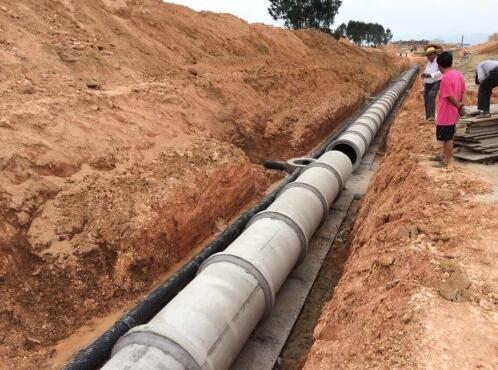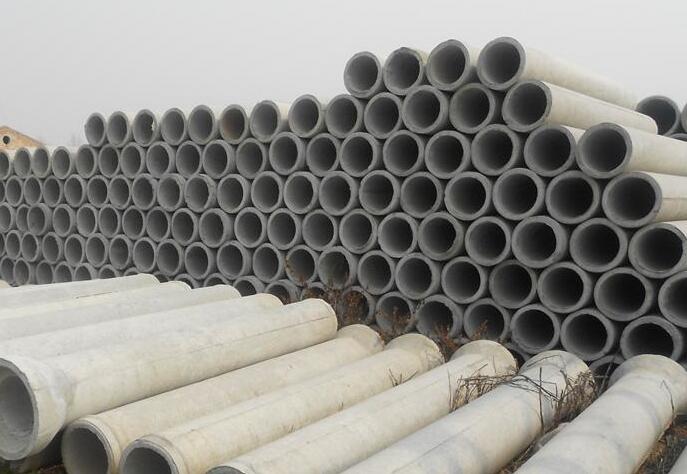News
Why Concrete Pipe? REASONS TO CHOOSE CONCRETE PIPE

Strength
Precast Concrete pipe is the strongest pipe available and can be designed and tested to meet any loading condition. Unlike flexible pipe, concrete pipe has the majority of the required strength built into the pipe, and is much less dependent upon the installation of the pipe. Concrete pipe is manufactured per ASTM C-76 and AASHTO M 170 in strength classes ranging from Class I to Class V. These strengths are verified by a 3 Edge Bearing or D-Load test performed in the plant.
In today’s economic environment, designing for long term, sustainable project performance is imperative for the Engineer. Unlike some alternate pipe materials, concrete pipe has a proven track record of performance. Concrete pipe will not rust, burn, tear, buckle or deflect, and is immune to most environmental elements. The United States Army Corps of Engineers has recommended precast concrete pipe for a design life of 70-100 years, and there are numerous examples of installations that have exceeded these parameters.
A dependable product not only has to perform well, it must be completely understood and have the confidence of those who specify and use the product. Understanding how a product performs, being able to anticipate and prevent potential problems, and having experienced installation crews are vital to ensuring a well designed and constructed project. No pipe material on the market is better understood and more frequently used and depended upon more than reinforced concrete pipe. The proven record of use, and the continuous research and development of the concrete pipe industry have instilled confidence in the Engineering and Construction fields for many decades.
All drainage pipe serves one common purpose; to act as a conduit to move a certain amount of storm water from one point to another. This conduit, in conjunction with the surrounding soil, provides the structure the installation must provide. When using reinforced concrete pipe, in addition to the conduit, you get the majority of the structure necessary to support whatever type of load will be generated on top of the conduit. Unlike flexible pipe, where up to 95% of the structure must be painstakingly designed and installed in the field, up to 85% of the design strength of the installation is provided by the concrete pipe.
Concrete pipe will not burn. Thermoplastic pipe is highly flammable. TxDOT issued a directive in 2009 inn response to the Texas wildfires. This required any flammable pipe material to use varying lengths of non-flammable end treatments.
Buried infrastructure is an asset that is financed and maintained by the public or private entities that invest taxpayer or shareholder dollars into the project.
All of the costs of initial design, construction, material cost, inspection, and maintenance make up the total cost or “value” of an asset. Any asset that requires additional investment for repair, maintenance and/or replacement to maintain its’ value over the life of the asset actually adds to the owner’s cost of the asset.
In order to make the proper initial choice of materials, the owner must truly understand the asset, and the value or cost of the asset over the design life. Design, installation, and inspection costs of flexible pipe are greater than comparable concrete pipe costs. The asset value of concrete pipe will not drop over the life of the project.
Nearly every major or mid-size municipality has a concrete pipe manufacturer nearby. This allows for shorter delivery time and greater availability of product. It also means that the local manufacturing facilities are making product designed to local standards. If an issue arises, there is usually engineering and support personnel readily available. These manufacturers also employ a large number of local citizens and contribute to the tax base, thus supporting your local economy.
A least cost analysis is an effective method of evaluating two alternative materials with different service lives or economic equivalence. The factors which affect the traditional analysis are project design life, material life, first cost, interest rate, inflation rate, replacement costs, and residual value. First cost is important to the engineer and owner, but does not reveal the entire cost of the pipeline. Least cost analysis should also consider costs to the traveling public and businesses due to detours and replacement of potential catastrophic failures.
Flexible pipe products may have lower initial costs, but they are not as cost-effective as concrete pipe. Over the long term, flexible pipe has a shorter service life, and requires premium bedding and backfill. Installation procedures have to be precise for the bedding and backfill to take on the required structural characteristics. During and after installation, inspection of flexible pipe systems is critical to performance, and mandrel or laser/video testing is mandatory in many jurisdictions. In general, the true cost (installation, maintenance and replacement) of flexible pipe can be twice that of concrete based on a 50-year or greater service life.
When flexible products are specified correctly, reinforced concrete pipe can compete favorably at the same or lower cost! Concrete pipe is the strongest drainage product available, the most hydraulically efficient, and has great current and future value as an infrastructure asset.
Concrete pipe far out performs plastic or metal. Concrete’s rigidity and mass allow for easy and secure placement in the ditch, without disrupting line or grade. Plus, precast concrete pipe joints are easily assembled, which helps minimize the time needs for installation. When installation time matters, or when the soil poses challenges to installation, precast concrete pipe is quite simply the most logical and responsible option.
Since Concrete pipe is a rigid pipe system that is over 85% dependent on the pipe 7strength and only 15% dependent on the strength derived from the soil envelope, installation is made easy. In many situations, the installation of plastic or metal pipes can take longer than precast concrete pipe. That’s because the structural and hydraulic integrity of flexible pipes rely heavily on how well you prep the surrounding soil at installation, rather than on their own inherent brute strength. Making sure all conditions are right and installing per national specifications can be a costly and time-consuming proposition when installing flexible pipe.

Leave Message
If you have any problems or questions about our products or need our support and assistance, please feel free to write us, we will reply to you within 24 hours, and never reveal your information to the third party. Thank you!
PRODUCTS SEARCH
Quickly find productPRODUCTS LIST
- QT4-25 block making machine
- QMJ-10A Egg-laying Block Ma...
- QTY4-30 Egg Laying Block Ma...
- QTJ4-40 Semi-auto Block Mak...
- QTJ4-35 Semi-auto Block Mak...
- QTJ4-26 Semi-auto Block Mak...
- QTJ4-25 Auto Block Making M...
- Concrete Mixing Pump
- Trailer Concrete Pump
- HY600 Self-loading Concrete...
